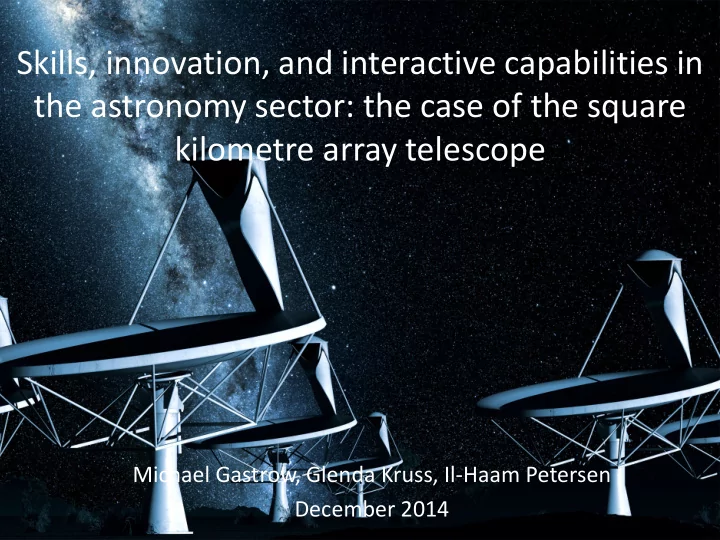

Skills, innovation, and interactive capabilities in the astronomy sector: the case of the square kilometre array telescope Michael Gastrow, Glenda Kruss, Il-Haam Petersen December 2014
Outline • Astronomy and the SKA • The Labour Market Intelligence Research Partnership • Research question and theoretical framework • Methodology • The Astronomy Sectoral System of Innovation • Skills demand • Skills supply • Interactive capabilities • Challenges • Success factors
South African Astronomy and the Square Kilometre Array • How do galaxies evolve and what is dark energy? • Are we alone? SETI ? • How were the first black holes and stars formed? • What generates the giant magnetic fields in space? • Was Einstein right? • Blue sky research…
The Labour Market Intelligence Research Partnership
Skills alignment through interaction We can create projections for skills needed in specific sectors… But these have limited utility without also understanding how organisations interact to match the supply of and demand for skills… Our research question : How do we address skills gaps by improving alignment between the E&T system and employers?
Innovation systems framework • Systemic framework : innovation and knowledge / actors and relationships • Knowledge generation role of universities : strategies and mechanisms • Focus on skills development , and across the post-school system • Potential value?
Research approach Theoretical stance : innovation systems approach / dynamic interactive capabilities What are the main components in the SSI addressing skills needs? • How do employers meet routine and non-routine skills needs? • How do public and private sector intermediary organisations build • network alignment? What are the interactive capabilities of the E&T system to address the skills • needs of employers? What is the nature of mis/alignment between skills supply and demand? • What are the challenges/constraints/threats to growth and skills • development? > Identify opportunities for improved interaction and system configuration
Methodology • Mapping the SIS • Key informant interviews • Analysis focussing on: – Competences – (Dynamic, interactive) capabilities – Network (mis)alignment – Opportunities for improvement
Innovation System for Astronomy and the SKA
SKA Organisation (international) Organistional structure = Ten Consortia AIV CSP (DSH) INFRA LFAA MFAA SADR SDP TM WBSPF · Commonwealth Scientific and Industrial Research Organization (CSIRO), Australia · RPC Technologies, Australia · National Research Council, Canada · Joint Laboratory for Radio Astronomy Technology (JLRAT), China · Max Planck Institute for Radio Astronomy (MPIfR), Germany · Vertex Antennentechnik, Germany Localised Innovation Network · IAF Fraunhofer, Germany · National Institute of Astrophysics (INAF), Italy Stellenbosch University · European Industrial Engineering (EIE), Italy EMSS MNC parent company · Società Aerospaziale Mediterranea (SAM), Italy EMSS suppliers · SKA South Africa, South Africa SKA engineers · EM Software and Systems (EMSS), South Africa plus other collaborating partners · Spain University Group, Spain · Chalmers University/Onsala Space Observatory, Sweden · Omnisys Instruments AB, Sweden Dish Consortuim
Skills demand and interactive capabilities SKA Firms Formal structures and Searching for skills: mechanisms: • More network mechanisms • HCDP • Less market mechanisms • Universities working group • SKA design consortia • Technology forecasting Formal mechanisms: • SKA design consortia Tacit interactive capabilities: • Global innovation networks • Informal relationships with key actors • Scientists and engineers within HEIs
Skills supply and interactive capabilities • Universities: Example: University of Stellenbosch Engineering faculty • Niche competences and capabilities: • Responsive teaching and learning • Institutions • Responsive research and innovation + collaborative R&D networks • Departments (e.g. Astronomy) • Academic networks • Faculties (e.g. Engineering) • Advisory boards • Individual academics • 5 year review process • NASSP • Academic time allocations for • Universities Working Group working in industry • Contract R&D for industry • FET ? • Funding for equipment • Close engagement with engineering professional body • Invited speakers from firms • Strategic interaction with GOV
Intermediaries Public Sector Private Sector SA: DST IAU • • NRF OAD • • SAAO • DHET (SIPs) • Policy support • International: NRAO • AERAP •
Lessons for policy: interaction and systemic alignment Challenges : Sourcing international skills • Slow rate of undergrad curriculum change • FET limitations • Successes achieved through: Funding • Risks • Policy • Interactive capabilities in the SKA • Interactive capabilities in the higher education system • Skills planning • Formal and informal networks connect employers and universities • Q: can this success be replicated in other knowledge-intensive sectors?
Skills, innovation, and interactive capabilities in the astronomy sector: the case of the square kilometre array telescope Michael Gastrow, Glenda Kruss, Il-Haam Petersen December 2014
Recommend
More recommend